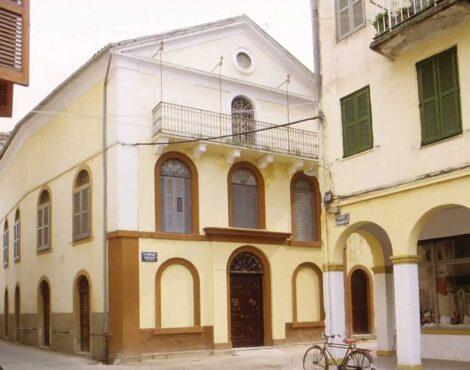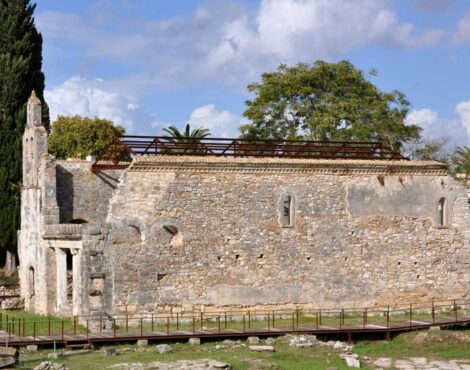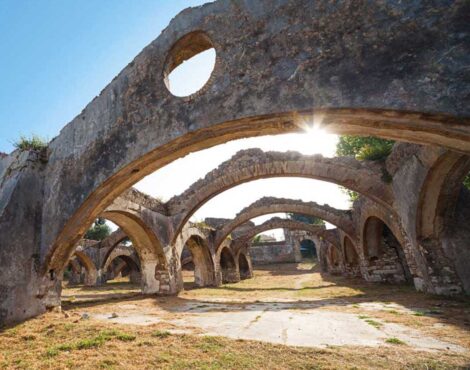Corfu is rightfully known for its vibrant musical tradition, its philharmonic bands, and its parades. Yet beneath this musical surface lies a world rich in imagery, movement, language, and material: a world of other arts that together shape the island’s deeper cultural identity. From painting and sculpture to theater, literature, and folk arts, Corfu is a living, breathing land of artistic creation with a long-standing history and an active present. In this review, we will explore those dimensions of the island’s artistic expression that often remain overshadowed by its prominent musical heritage.
Painting in Corfu has deep roots and stands out particularly due to the influence of the Heptanese School, which acted as a bridge between Byzantine iconography and Western techniques. Panagiotis Doxaras is considered the founder of modern Greek painting, having introduced Italian styles and broken away from the monotony of traditional religious iconography. His son, Nikolaos Doxaras, continued his legacy, and later painters such as Angelos Giallinas, known for his meticulously detailed watercolors, and Charalambos Pachis, celebrated for his portraits and depictions of everyday life, helped establish painting as a strong form of artistic expression. Today, their works are exhibited at the Museum of Asian Art, the Corfu Art Gallery, and in private collections. At the same time, contemporary Corfiot visual artists continue to draw inspiration from the island’s natural and cultural landscape, bringing painting to life in exhibitions, galleries, and public spaces.
Sculpture in Corfu has traditionally been linked to the decoration of churches, funerary monuments, and public areas. The island’s Venetian past left a vivid mark through stone reliefs and busts, while in more recent years, artists have emerged who combine traditional and modern materials. In Spianada Square, around the old fortresses, and across many city neighborhoods, one can find sculptures that honor historical figures as well as abstract compositions that bridge the past with the present. Sculpture today maintains a public, often silent, role—one closely tied to memory and the island’s historical consciousness.
The theatrical tradition of Corfu is notably rich. As early as the 17th century, the island boasted theatrical venues influenced by Venetian culture. The Corfu Municipal Theater (which was destroyed during World War II) was once one of the most important centers of opera and performing arts in the Balkans. Today, theater remains alive through cultural associations, amateur groups, festivals, and acting workshops. Although it does not receive as much attention as the island’s music scene, Corfu’s theater continues to thrive with an engaged and passionate audience.
Corfu has long served as both a haven and a creative ground for prominent writers. The national poet Dionysios Solomos spent a large part of his life on the island, where he was inspired to compose many of his most important poems. His house now functions as a museum. Konstantinos Theotokis, another distinguished Corfiot, holds a significant place in modern Greek literature. His ethnographic and socially-oriented novels vividly depicted Corfu of his time, particularly through works like “Honor and Money.” In the modern era, literary production continues with poets, prose writers, and playwrights actively contributing to publications, book presentations, and writing festivals, thereby keeping the island’s literary pulse alive and well.
The arts of everyday life, such as pottery, weaving, and embroidery, are also a living part of Corfu’s cultural identity. In many villages, especially in the southern part of the island, traditional workshops still operate, while older women pass down their techniques to younger generations. The making of traditional costumes, handcrafted musical instruments, iconography, and woodcarvings in churches are all forms of applied art that blend aesthetic value with functionality and respect for local traditions.
The Ionian University, with its Departments of Music Studies and Audio & Visual Arts, has added a fresh dynamic to the cultural landscape of the island. Young artists experiment with video, multimedia, photography, and performance art, creating bridges between tradition and contemporary expression. Annual events such as the Arts Festival and the Corfu Art Festival provide a platform for modern creation, collaboration with international artists, and interaction with the public.
Corfu is not merely a musical island. It is a place filled with images, narratives, scenes, and textures. From great painters and literary figures to folk artisans and modern creators, the artistic soul of the island beats strongly and polyphonically. The arts in Corfu do not operate in isolation, they complement one another: music inspires painting, painting meets sculpture, theater intersects with literature, and together they form a cultural universe with depth and coherence.





